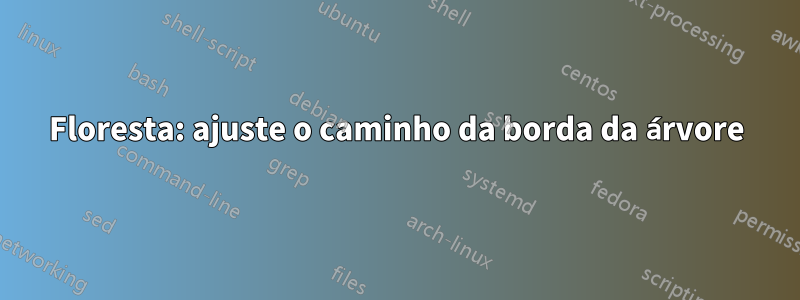
Eu quero desenhar uma árvore como a mostrada emeste tópico. No entanto, o texto nos meus nós pode ser longo e causar quebras de linha. Então, a anchor=150opção do thread atrapalha o alinhamento horizontal dos grandchildrennós. Quando uso anchor=westo alinhamento horizontal está bom, mas os nós se deslocam para a direita e cruzam a próxima coluna.
O que posso fazer para evitar isso?
MWE
\documentclass{standalone}
\usepackage{forest}
\usetikzlibrary{arrows.meta}
\usetikzlibrary{calc}
\usetikzlibrary{decorations.markings}
% \usetikzlibrary{fpu}
\usetikzlibrary{intersections}
\usetikzlibrary{trees}
\usetikzlibrary{matrix}
\usetikzlibrary{positioning}
\usetikzlibrary{shadows}
\useforestlibrary{edges}
\tikzset{
parent/.style={align=center,text width=4cm,fill=gray!50,rounded corners=2pt},
child/.style={align=center,text width=2.5cm,fill=gray!20,rounded corners=6pt},
grandchild/.style={fill=white,text width=2.3cm}
}
\begin{document}
\begin{forest}
for tree={%
thick,
drop shadow,
l sep=0.8cm,
s sep=1.0cm,
node options={
draw,
font=\sffamily
},
edge={
semithick,
-Latex
},
where level=0{parent}{},
where level=1{
minimum height=1cm,
child,
parent anchor=south west,
tier=p,
l sep=0.45cm,
for descendants={%
grandchild,
minimum height=0.6cm,
anchor=west,
edge path={
\noexpand\path[\forestoption{edge}]
(!to tier=p.parent anchor) |-(.child anchor)\forestoption{edge label};
},
}
}{},
}
[\large Long text with line break%
[\textbf{Test 1} \\ with a lot of subtext%
[Topic%
[Long topic with line break%
[Topic%
]]]%
]
[\textbf{Test 2} \\ with a lot of subtext%
[Topic%
[Long topic with line break%
[Topic%
]]]%
]
[\textbf{Test 3} \\ with a lot of subtext%
[Topic%
[Long topic with line break%
[Topic%
]]]%
]
[\textbf{Test 4} \\ with a lot of subtext%
[Topic%
[Long topic with line break%
[Topic%
]]]%
]
]
\end{forest}
\end{document}
Resultado
Responder1
Você está carregando a edgesbiblioteca, mas na verdade não a utiliza, o que é estranho, pois esse é precisamente o tipo de estilo que ela suporta. Além disso, elimina a necessidade de falsificar a estrutura da árvore, permitindo manter as relações intuitivas entre pais e filhos em sua marcação.
Neste caso, o folderestilo é a escolha óbvia, pelo menos ignorando o seu nome enganador. O único problema é que ele não faz a coisa certa quando se aplica apenas além de um certo nível e, como tenta fazer a coisa certa de maneira inteligente, você precisa substituí-lo no final do processamento da árvore.
Por exemplo,
\documentclass[border=10pt]{standalone}
\usepackage[edges]{forest}
\usetikzlibrary{shadows,arrows.meta}
\tikzset{
parent/.style={align=center,text width=4cm,fill=gray!50,rounded corners=2pt},
child/.style={align=center,text width=2.5cm,fill=gray!20,rounded corners=6pt},
grandchild/.style={fill=white,text width=2.3cm}
}
\begin{document}
\begin{forest}
for tree={%
thick,
drop shadow,
node options={
draw,
font=\sffamily
},
edge={
semithick,
-Latex
},
where level=0{
parent,
l sep'=0.8cm,
s sep'=1.0cm,
}{
folder,
grow'=0,
},
where level=1{
minimum height=1cm,
child,
l sep=7.5mm,
for descendants={%
grandchild,
minimum height=0.6cm,
},
for children={
before computing xy={s+=5mm},
}
}{},
}
[\large Long text with line break%
[\textbf{Test 1} \\ with a lot of subtext%
[Topic]
[Long topic with line break]
[Topic]
]
[\textbf{Test 2} \\ with a lot of subtext%
[Topic]
[Long topic with line break]
[Topic]
]
[\textbf{Test 3} \\ with a lot of subtext%
[Topic]
[Long topic with line break]
[Topic]
]
[\textbf{Test 4} \\ with a lot of subtext%
[Topic]
[Long topic with line break]
[Topic]
]
]
\end{forest}
\end{document}



